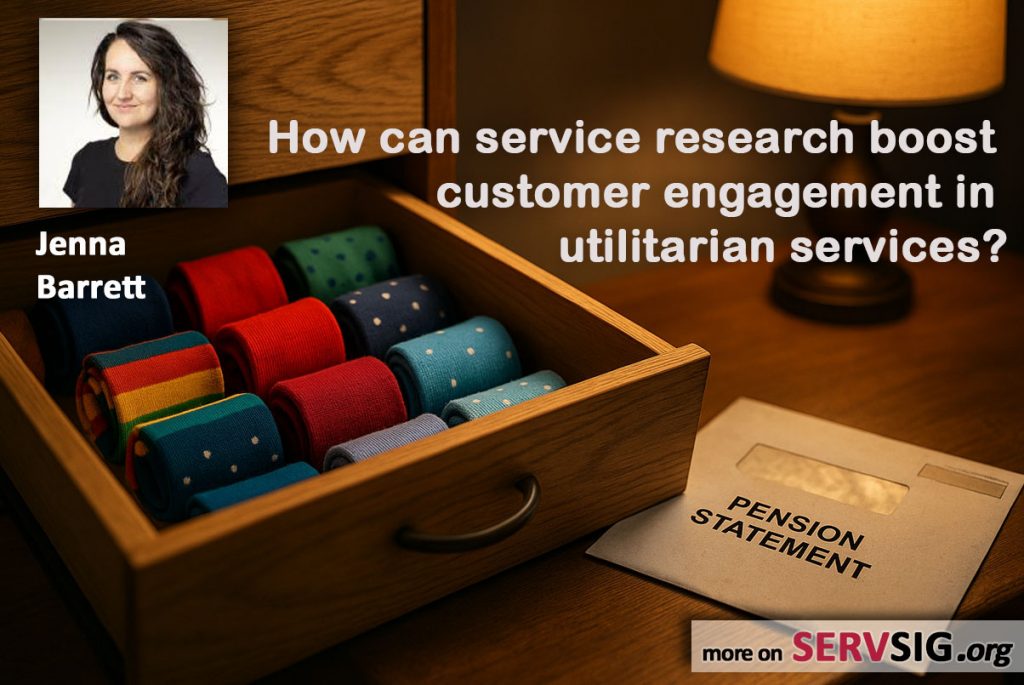Guest article by Jenna Barrett, finalist of the 2025 SERVSIG Best Dissertation Award.

When I present my research, I often open with a very simple question. Imagine it is Sunday evening, you’ve had a busy week, but you still have a tiny bit of energy left to do something productive. What would you prefer?
- You finally sort out your sock drawer
- You finally have a look at your pension overview
Did you choose option A? Generally, this option gets a large majority of the votes. Even when I ask this question to practitioners working in financial services (these people really like numbers), option A wins by a landslide.
This is not because we are overly excited about sorting out our sock drawer – we can replace the sock drawer with any mundane task such as vacuum cleaning, doing laundry or cleaning the bathroom – it is the pension overview option that people find particularly aversive and non-engaging.
This is illustrative of a larger problem. Across a wide range of utilitarian services such as financial planning, insurance, energy use, or healthcare, engagement is low.[1] An interesting paradox is that people do agree that these services are important, and they report that they wish to learn more about them. However, when that information is presented to them, the e-mails tend to remain unread.
This disconnect is especially pronounced in contexts like retirement planning, where the benefits are far in the future. Behavioral research has shown that people struggle to devote attention today to outcomes that are uncertain and distant[2] (Trope & Liberman, 2003).
This gap between importance and engagement creates a real challenge, especially for service research: how can we boost engagement in areas that are fundamental to our well-being?
In theory, engagement is a personal responsibility: people should pay attention to their finances. But in practice, the systems themselves are often complex, especially during periods of stress or major life transitions in which financial decisions matter most.
In financial services we often focus on communicating numerical information to consumers. However, this numerical information may not be the most meaningful way to create engagement. Especially in contexts where customer engagement is low, and skill is required to understand information, financial service providers should seek innovative ways to create meaning for consumers.
One promising direction comes from shifting how information is communicated. People rarely connect with abstract numbers or timelines, especially when the benefits are far off in the future. Accompanying numerical information with meaningful information, such as how saving decisions in the present affect consumption possibilities in the future may encourage action. [3]
Next, the service research field has a unique opportunity to explore the interplay between the individual consumer and the broader system in which decisions are made. This aligns closely with the ongoing discussion around the I-frame (individual responsibility) versus the S-frame (systemic responsibility)[4]. Often, the burden of action is placed on individuals. We assume consumers should educate themselves, stay motivated, and make the “right” decisions, even when the environment makes this unnecessarily difficult. But service design offers a way to shift from the I-frame to the S-frame: by creating systems that support better outcomes without requiring constant attention, expertise, or willpower. Good design can lower the cognitive and emotional cost of participation.
All of this points to a broader shift in how we think about consumer engagement. If we see that consumers indicate that they want to be engaged, but we do not see this intention translating into behavior, we need to reconsider the systems in which we want engagement to take place. We should reconsider what engagement means in the context at hand: are we providing relevant information that the consumer can interpret in a meaningful way? As a field, we should go beyond transactional metrics (clicks, logins, conversions), and also study whether we are able to help consumers to meaningfully engage with services that matter to their well-being.
So yes, on some evenings, the sock drawer will probably keep winning. Sorting socks is a task that may seem easier to accomplish than planning for retirement. But as we uncover better ways to facilitate customer engagement in utilitarian services, maybe one day looking at your pension overview won’t feel like such a chore anymore. Maybe, in the future, the socks will have some serious competition.
Jenna Barrett
Assistant Professor
Tilburg School of Economics and Management
References:
[1] Barrett, J. A. M., Jaakkola, E., Heller, J., & Brüggen, E. C. (2024). Customer engagement in utilitarian vs. hedonic service contexts. Journal of Service Research, 10946705241242901.
[2] Trope, Y., & Liberman, N. (2003). Temporal construal. Psychological review, 110(3), 403.
[3] Barrett, A. M. (2024). Money matters: understanding and improving financial well-being.
[4] Chater, N., & Loewenstein, G. (2023). The i-frame and the s-frame: How focusing on individual-level solutions has led behavioral public policy astray. Behavioral and Brain Sciences, 46, e147.


